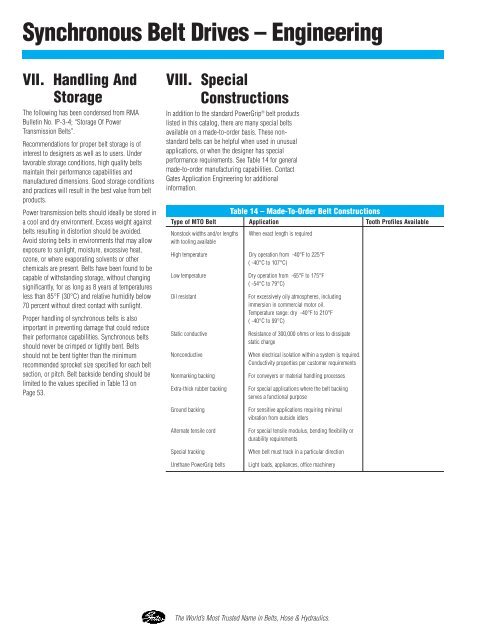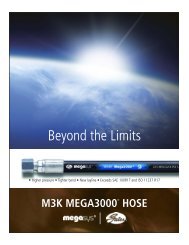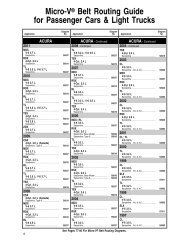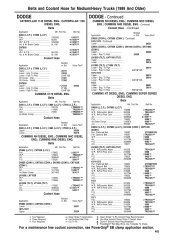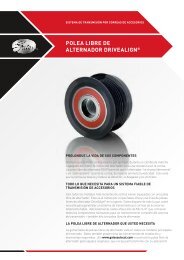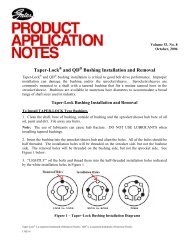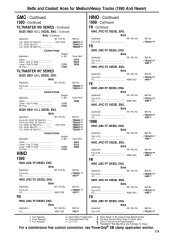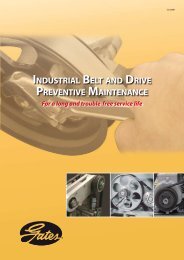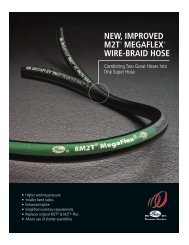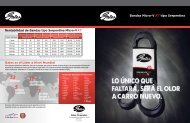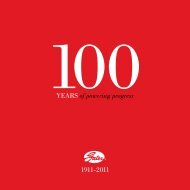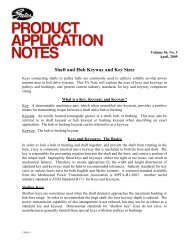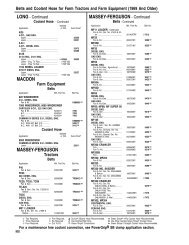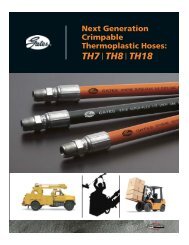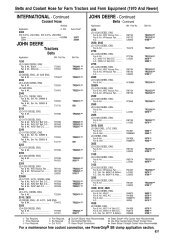PowerGrip® GT® Belt Drives
PowerGrip® GT® Belt Drives
PowerGrip® GT® Belt Drives
You also want an ePaper? Increase the reach of your titles
YUMPU automatically turns print PDFs into web optimized ePapers that Google loves.
Synchronous <strong>Belt</strong> <strong>Drives</strong> – Engineering<br />
VII. Handling And<br />
Storage<br />
The following has been condensed from RMA<br />
Bulletin No. IP-3-4; “Storage Of Power<br />
Transmission <strong>Belt</strong>s”.<br />
Recommendations for proper belt storage is of<br />
interest to designers as well as to users. Under<br />
favorable storage conditions, high quality belts<br />
maintain their performance capabilities and<br />
manufactured dimensions. Good storage conditions<br />
and practices will result in the best value from belt<br />
products.<br />
Power transmission belts should ideally be stored in<br />
a cool and dry environment. Excess weight against<br />
belts resulting in distortion should be avoided.<br />
Avoid storing belts in environments that may allow<br />
exposure to sunlight, moisture, excessive heat,<br />
ozone, or where evaporating solvents or other<br />
chemicals are present. <strong>Belt</strong>s have been found to be<br />
capable of withstanding storage, without changing<br />
significantly, for as long as 8 years at temperatures<br />
less than 85°F (30°C) and relative humidity below<br />
70 percent without direct contact with sunlight.<br />
Proper handling of synchronous belts is also<br />
important in preventing damage that could reduce<br />
their performance capabilities. Synchronous belts<br />
should never be crimped or tightly bent. <strong>Belt</strong>s<br />
should not be bent tighter than the minimum<br />
recommended sprocket size specified for each belt<br />
section, or pitch. <strong>Belt</strong> backside bending should be<br />
limited to the values specified in Table 13 on<br />
Page 53.<br />
VIII. Special<br />
Constructions<br />
In addition to the standard PowerGrip ® belt products<br />
listed in this catalog, there are many special belts<br />
available on a made-to-order basis. These nonstandard<br />
belts can be helpful when used in unusual<br />
applications, or when the designer has special<br />
performance requirements. See Table 14 for general<br />
made-to-order manufacturing capabilities. Contact<br />
Gates Application Engineering for additional<br />
information.<br />
Type of MTO <strong>Belt</strong> Application Tooth Profiles Available<br />
Nonstock widths and/or lengths<br />
with tooling available<br />
When exact length is required<br />
High temperature Dry operation from -40°F to 225°F<br />
( -40°C to 107°C)<br />
Low temperature Dry operation from -65°F to 175°F<br />
( -54°C to 79°C)<br />
Oil resistant<br />
Static conductive<br />
Nonconductive<br />
Nonmarking backing<br />
Extra-thick rubber backing<br />
Table 14 – Made-To-Order <strong>Belt</strong> Constructions<br />
For excessively oily atmospheres, including<br />
immersion in commercial motor oil.<br />
Temperature range: dry -40°F to 210°F<br />
( -40°C to 99°C)<br />
Resistance of 300,000 ohms or less to dissipate<br />
static charge<br />
When electrical isolation within a system is required.<br />
Conductivity properties per customer requirements<br />
For conveyers or material handling processes<br />
For special applications where the belt backing<br />
serves a functional purpose<br />
Ground backing<br />
Alternate tensile cord<br />
Special tracking<br />
Urethane PowerGrip belts<br />
For sensitive applications requiring minimal<br />
vibration from outside idlers<br />
For special tensile modulus, bending flexibility or<br />
durability requirements<br />
When belt must track in a particular direction<br />
Light loads, appliances, office machinery<br />
The World’s Most Trusted Name in <strong>Belt</strong>s, Hose & Hydraulics.


